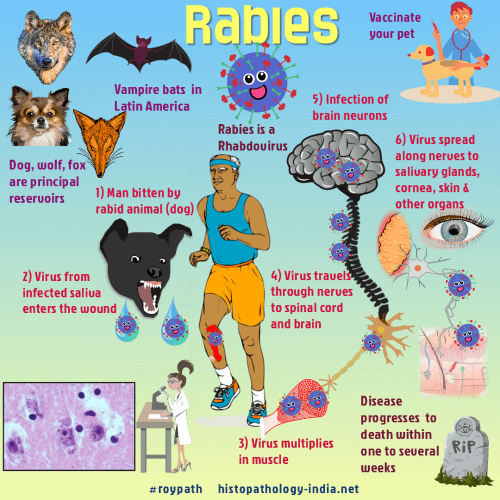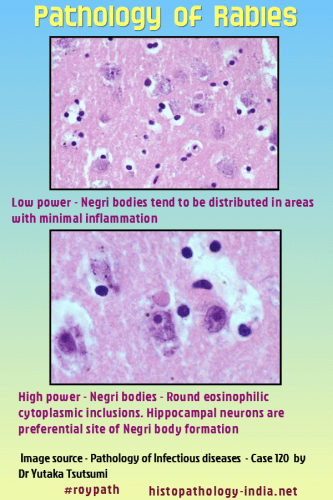|

Custom Search
|
|
Infectious Disease Online Pathology of Rabies
|

|
Rabies is a preventable viral disease of mammals most often transmitted through the bite of a rabid animal. [ Note -Rhabdoviruses are RNA viruses with a single stranded RNA genome. The nuclear capsid is enclosed within a bullet-shaped capsid that measures 175x75 nm. Rhabdoviruses infect vertebrates, insects and plants. The most important Rhabdovirus in human is Rabies.] Globally more than 55000 people die of rabies each year, about 95% in Asia and Africa. Rabies remains as one of the most feared zoonotic diseases in the world. In human rabies virus infects the central nervous system, ultimately causing disease in the brain (lethal encephalitis) and death. Carnivores, such as the dog, wolf, fox, and skunk, are the principal reservoirs, but the infection extends to bats and to some domesticated animals, such as cattle, goats, and swine. Bats are important reservoirs for emerging infectious diseases, yet the mechanisms that allow highly virulent pathogens to persist within bat populations remain obscure. In Latin America, vampire-bat-transmitted rabies virus represents an important example of how such uncertainty can hamper efforts to prevent cross-species transmission. The infectious agent is transmitted to humans through contaminated saliva introduced into the wound of an animal bite ( Example - rabid dog bite) The virus enters a peripheral nerve and is transported by centripetal axoplasmic flow to the spinal cord and brain. The latent interval varies in proportion to the distance of transport, being as short as 10 days or as long as 3 months. Centrifugal intra-axonal transport of the virus contaminates visceral organs, particularly the salivary glands, which in turn contaminate the saliva. Although it is not understood why the virus seeks out the brain stem, this pattern of localization initiates the classic symptoms of difficulty in swelling and the painful spasms of the throat that justify the term hydrophobia. The clinical symptoms include irritability, agitation, seizures, and delirium and reflect a general encephalopathy. The spinal fluid is altered in accord with the "typical viral response" : a modest pleocytosis by lymphocytes, a moderate elevation of protein content (15 to 100 mg/ml), and an unaltered glucose level and spinal fluid pressure. The illness progresses to death within one to several weeks. Grossly the brain and spinal cord show edema and petechial hemorrhages. Involvement of the spinal cord is most conspicuous when the portal of entry is on the lower part of the body. Lymphocytes aggregate about the small arteries and veins in the brain stem. Scattered neurons show chromatolysis and neuronophagia. Glial nodules attest to the infectious nature of the process. The geographic distribution of the inflammation, centered in the brain stem with spillage into the cerebellum and hypothalamus, strongly suggests rabies.
In about 75% of cases Negri bodies can be seen on hematoxylin and eosin stained sections. Related post: Negri bodies The control of rabies largely depends on the prevention of infection of dogs and cats by vaccination in endemic areas and the control of their movement, including measures of quarantine and vaccination, in rabies-free countries.
|
|
|
Copyright © 2022 histopathology-india.net


